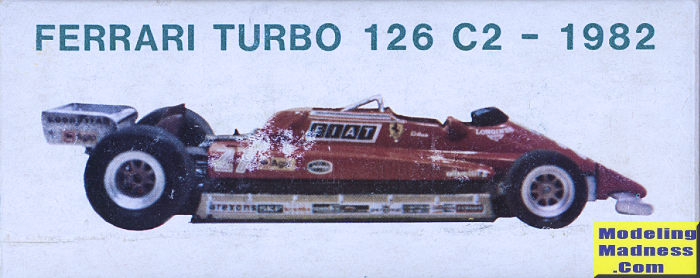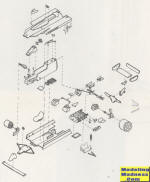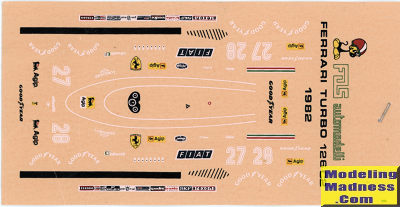FDS 1/43 Ferrari Turbo 126C2 - 1982
|
KIT #: |
703 |
|
PRICE: |
$34.95 when new in the early 1990s. |
|
DECALS: |
Two options |
|
REVIEWER: |
Scott Van Aken |
|
NOTES: |
Mostly cast metal |

The Ferrari 126C was a 1.5 liter turbocarged F.1 car that was used from 1981
through 1984. The arrival of Harvey Postlethwaite led to a total overhaul of
the car in time for the 1982 season. The turbo engine was further developed
and reliability found, while an all-new chassis and bodywork were designed,
featuring Ferrari's first genuine full monocoque chassis with honeycomb
aluminum panels for the structure, which made it more similar to its British
specialist competitors' cars than any of Ferrari's previous F1 cars had been
since 1962. Smaller, nimbler and with vastly improved aerodynamics, the
126C2 handled far better than its predecessor, although due to its heavier
weight thanks to the turbo-charged engine made it slower around corners than
its rivals. Villeneuve and Pironi posted record times in testing with the
new car and began the season with several solid results, even though Pironi
had a gigantic accident during testing at the Paul Ricard circuit, of which
he was lucky to escape alive. The car made its debut at South Africa in
January of that year, where both cars retired and at the Long Beach Grand
Prix in America 2+1⁄2 months
later, the car was fitted with an unusual configuration of two thin rear
wings, each individually as wide as the regulations allowed, but placed
side-by-side and staggered fore and aft, making it effectively a single
double-wide wing. This was done as a deliberate exploitation of rule
loopholes in retaliation for Williams' "water-cooled brakes" exploit at the
previous race in Brazil, and to send a political message to the governing
body, which was part of the FISA–FOCA wars, which resulted in
disqualification for Villeneuve, who finished the race in 3rd. Then came the
infamous race at San Marino after which Villeneuve accused Pironi of having
disobeyed team orders. The fallout from the race preceded Villeneuve's death
in an horrific accident during qualifying at the next round in Belgium,
which left Pironi as team leader. Ferrari did not enter a second car for the
next three races, before ultimately drafting in Patrick
Tambay to replace Villeneuve. He managed three podium finishes,
including a win in Germany, en route to a fifth place in the championship
despite only having driven half the season. Pironi himself was nearly killed
in Germany in
a similar accident as Villeneuve's, putting an end to his motor racing
career. Again they did not enter a second car for two races, before bringing
in Mario
Andretti as Pironi's replacement. The American finished on the podium
alongside his teammate in Ferrari's home race. Despite the turbulent season,
Ferrari won the constructors' championship that year. The 126C2 was further
developed during the season, with new wings and bodywork tried, and the
engine's power boosted to 650 bhp (485 kW; 659 PS) in qualifying trim and
around 600 bhp (447 kW; 608 PS) in races. An improved chassis was designed
and developed mid-season that was introduced for the French Grand Prix that
changed the rocker arm front suspension to a more streamlined pull-rod,
rising rate suspension. A thinner longitudinal gearbox was also designed and
developed to replace the transverse gearbox to promote better undisturbed
airflow from the underside of the ground-effects chassis's side-pods.
 Back in the late 1980s-early
1990s, I bought a lot of 1/43 car kits. Many of them were metal F.1 cars
produced by the Italian company FDS. I was often able to find them on sale in
local shops as it seems they were not very popular in San Diego, where I lived
at the time. This is one of those kits. Retailing at $34.95, I was able to pick
it up for $15.00 so it was quite a savings.
Back in the late 1980s-early
1990s, I bought a lot of 1/43 car kits. Many of them were metal F.1 cars
produced by the Italian company FDS. I was often able to find them on sale in
local shops as it seems they were not very popular in San Diego, where I lived
at the time. This is one of those kits. Retailing at $34.95, I was able to pick
it up for $15.00 so it was quite a savings.
FDS kits are all cast metal that include rubber tires and sometimes, a small
vacuformed piece for the windscreen. They generally build up well, but do
require quite a bit of preparation to remove mold seams and then the wise
modeler will do a lot of test fitting. As these kits require either epoxy or
super glue, they are not for beginners. This kit in particular as there are a
lot of small parts and some of the subassemblies are fairly complex.
You can see this in the exploded view that is provided as a building guide.
This sort of instruction sheet is pretty standard with 1/43 car kits. You will
notice that there is no color information provided during the build. Unlike
earlier  kits,
this one does include color photos of the completed kit to assist with the
build. Nowadays, we have the benefit of the Internet to provide us with images
of the real car, something that we didn't have back when I bought this kit. At
that time, we had to rely on books to help us out in this regard.
kits,
this one does include color photos of the completed kit to assist with the
build. Nowadays, we have the benefit of the Internet to provide us with images
of the real car, something that we didn't have back when I bought this kit. At
that time, we had to rely on books to help us out in this regard.
The kit has a decal sheet that is probably going to need some help with a
coat of decal film and provides liveries for two drivers. The #27 car of Gilles
Villeneuve, and the #28 car of Didier Pironi.
If you can find one of these and feel you have the skills to
build an all metal kit, then this would be a good one for you. I can tell you
that if all goes well, the end result will be a superb model for your display
area.
https://en.wikipedia.org/wiki/Ferrari_126C
May 2024 Copyright ModelingMadness.com. All rights reserved. No
reproduction in part or in whole without express permission from the editor.
If you would like your product reviewed fairly and fairly quickly, please contact the editor or see other details in the
Note to
Contributors.
Back to the Main Page
Back to the Review
Index Page
Back to the Previews Index Page


 Back in the late 1980s-early
1990s, I bought a lot of 1/43 car kits. Many of them were metal F.1 cars
produced by the Italian company FDS. I was often able to find them on sale in
local shops as it seems they were not very popular in San Diego, where I lived
at the time. This is one of those kits. Retailing at $34.95, I was able to pick
it up for $15.00 so it was quite a savings.
Back in the late 1980s-early
1990s, I bought a lot of 1/43 car kits. Many of them were metal F.1 cars
produced by the Italian company FDS. I was often able to find them on sale in
local shops as it seems they were not very popular in San Diego, where I lived
at the time. This is one of those kits. Retailing at $34.95, I was able to pick
it up for $15.00 so it was quite a savings.  kits,
this one does include color photos of the completed kit to assist with the
build. Nowadays, we have the benefit of the Internet to provide us with images
of the real car, something that we didn't have back when I bought this kit. At
that time, we had to rely on books to help us out in this regard.
kits,
this one does include color photos of the completed kit to assist with the
build. Nowadays, we have the benefit of the Internet to provide us with images
of the real car, something that we didn't have back when I bought this kit. At
that time, we had to rely on books to help us out in this regard.